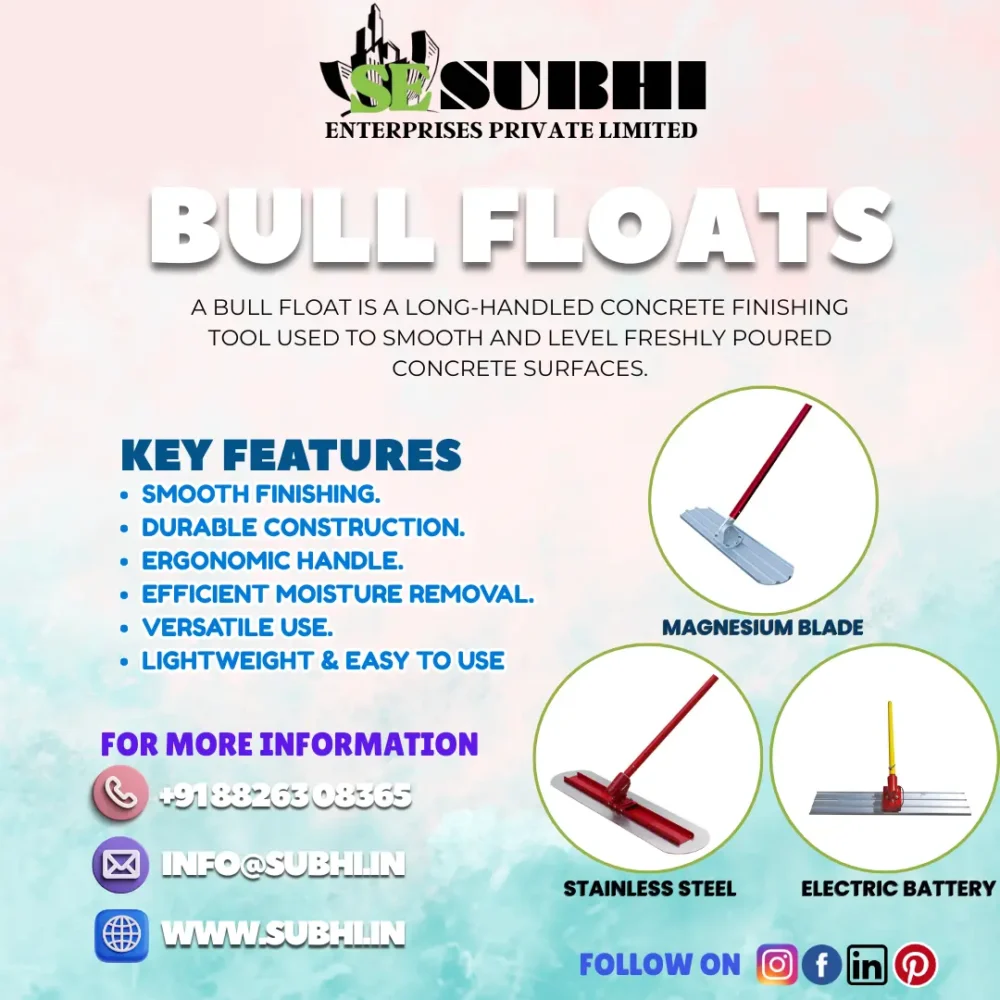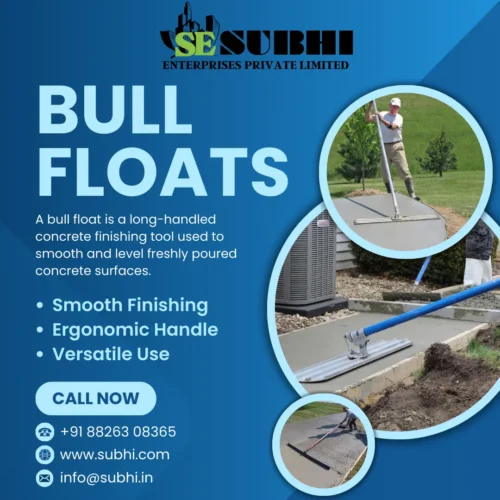Having the proper tools when finishing concrete can greatly help the task. A tool that every contractor, mason, and DIY buff should know about is the bull float. If you have a driveway, patio, or even a sidewalk in front of your business, using bull floats will help ensure the concrete surface is smooth and level. In this in-depth guide, we will explain all the common questions people have about bull floats including what are floats used for, their different types, their benefits, how to use them properly, and care tips.
What is a Bull Float?

A bull float is a flat tool measured a few meters in length, used in the last stages of concrete finishing, with the intention on smoothing out the surface of still bubbling concrete, that has to be let set. It features a broad rectangle shaped float made out of aluminum, magnesium, or wood. It serves the single most important purpose of any float that is used for countertop or slab construction; is pushing coarse aggregate downwards and eliminating small voids in it for uniformity.
Why is a Bull Float Important?
For a myriad of reasons, floats are extremely useful when it comes to finishing concrete. Here’s why bull floats are indispensable:
It smooths concrete: Bull float removes the screeding ridges and surfaces that are not leveled.
Embeds Aggregate: Aids in leveling off aggregate material, allowing for a smother finish.
Prepares for Troweling: Sets the stage for crafting exquisite and sophisticated designs.
Reduces Surface Cracks: Helps in minimizing surface cracking by compacting the upper portion.
Saves Time & Effort: Finishing tasks are done in a shorter duration of time and effort compared to manual labor.
Categories of Bull Floats
Floats applied to bull constructions were divided into types based on their contour and the materials utilized. The four common shapes referred to as bull types are listed below:
1. Bull Floats Made Out of Wood
(i) Used for lightly-textured slabs, these are my favorites because they are made out of hardwood.
(ii) Soaks water, which is bad for long term use.
(iii) Capital investment is low, but the cost from frequent maintenance is significant over time.
2. Bull Floats Made Out Of Magnesium
(i) Many professionals prefer using these because of their light weight and strength.
(ii) It does not soak water, so there is no problem with the concrete’s surface.
(iii) Ensures surfaces are smooth with minimal effort.
3. Bull Floats Made Out Of Aluminum
(i) Less heavy than magnesium, but still not as light as magnesium.
(ii) They do not corrode, hence they are suitable for prolonged employment.
(iii) Preferable on large scale constructions.
4. Composite Bull Floats
(i) Designed from lighter than other bull float materials making it durable and lightweight doesn’t make it less effective.
(ii) Less common, but works with certain designs.
5. Contrasts Between Round-End and Square-End Bull Floats
(i) Round-End: Cleans edges and leaves smoother surfaces.
(ii) Square-End: More useful for bigger tasks because it covers a larger area. (click)

Recommended Procedures for Using a Bull Float
When To Use A Bull Float With Concrete Finishing
An important aspect of good work is knowing when a bull float must be used. It must be used right after it has been screeded and prior to any bleed water appearing. Overusing a bull float once bleed water surfaces will produce a weak, dusty finish at best.
Benefits of A Bull Float
(i) Surface Finish Improvement : It levels the surface completely, therefore smoothing it out entirely.
(ii) Saves Time : Because time and effort are saved while finishing the work, it makes the process time efficient.
(iii) Prepares For Further Finishing Work : It helps to get the surface ready to be troweled and polished at the end of the job.
(iv) Broader Applications : Includes also using the material for sidewalks and other commercial projects besides using it in driveways and patios.
(v) Associated Defect Mitigation : It assists in achieving this as a result of consolidated concrete compaction.
Things Not To Do When Using A Bull Float
Important points to keep in mind include the following: Even highly skilled contractors have issues with Bull Floats.
(i) Excessive Polishing : This brings a bad problem of greater than normal water content on the surface resulting in weaker surfaces.
(ii) Using Excessive Force : Results in waves and coarse work.
(iii) Floating Too Late : The only solution to this problem is smoothing very stiff concrete which will result from floating too late.
How to Choose the Right Bull Float
Selecting the optimal float is mostly dependent on what your project goals are. Consider these suggestions next time you pick a bull float.
(a) Material : Magnesium and aluminum are preferred since it makes using the float easier, and keeps its shape for long periods of time.
(b) Size : Smaller floats allow for better precise work, bigger float cover more area.
(c) Handle Length : Longer float handles are useful for maintaining working distance as well as for avoiding stepping on wet concrete.
(d) Edge Type : Square floats allow for covering more space, whereas round-end floats are better as they leave less marks behind.
(e) Flexibility : Certain styles offer greater control with angle adjustable mounting brackets.
Step 1: Wash the Area of Concrete
Check the borders to ensure they are not too rough, and that the surface has some degree of smoothness after screeding and pouring the concrete.
Step 2: Handle Fitting
Attach the float’s long handle. Most new models of bull floats come with adjustable or telescopic handles so that users can have a better experience.
Step 3: Begin Floating
(i) Place the float on the wet concrete and then push the float away.
(ii) Do not apply too much pressure as this will have negative consequences.
(iii) Do not lift the tool after stroking the float to avoid leaving higher ground uncoated.
Step 4: Changes in Angles Lead To Alterations In Peripheral Vision
(i) Always keep the leading edge higher, to stop dragging of concrete.
(ii) Make the angle changes easier with the use of an adjustable bull float bracket.
Step 5: Achieving a Smooth Surface
Continue floating the surface until all the cracks are gone and the surface is leveled. Be on the lookout for over-floating, as this may weaken the strength of the concrete surface.
Conclusion
Every contractor, as well as DIY enthusiast, should view a bull float as an indispensable tool for smoothing, refinishing, and even pouring concrete. With it, contractors can achieve a great finish while minimizing surface blemishes and maximizing durability. Learning different types, best usage practices, and maintenance tips for a concrete finisher are sure to make the most out of this tool.
Correct usage of a sturdy bull float will ultimately lead to efficiency in terms of time, money, and energy. If you’re looking to improve your concrete finishing technique, mastering the bull float is undoubtedly the best step towards achieving professional grade results.
